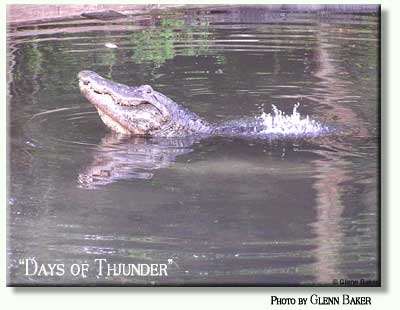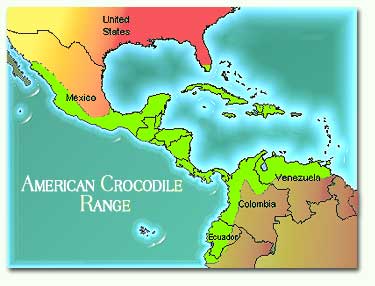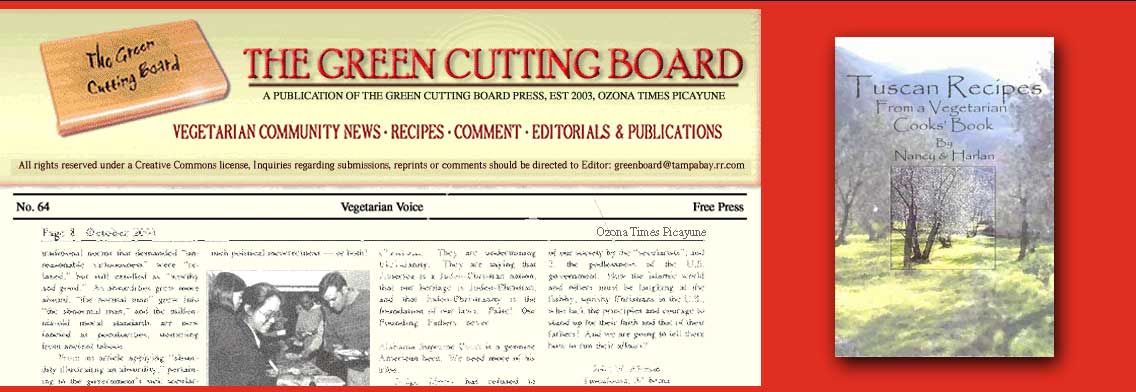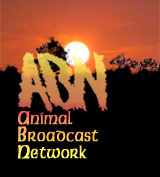Saturday, June 12, 2004
It's a Croc
The question is, why protect a creature, why protect any creature; the answer may come to you as you read this.

It was announced earlier this year that the U.S. Fish and Wildlife Service had taken under advisement a recommendation to down list the American Crocodile from endangered to protected which sounds for all intent and purpose a good thing, a success; a species pulled back from the brink of oblivion, We set about to understand how this was possible. This is our report on Saving Crocodilian.
Crocodiles along with alligators, caimans and gavials make up the order Crocodilian descended through 300 million years of evolution from the great reptiles to this point in time, in this place, they have come to be regarded in their new role, a new existence unfamiliar to a species of predators descended from the Thunder Lizards; as captive, managed, bred, farmed.

The American Crocodile, Crocodylus acutus inhabits a range (lime green on the map) that includes coastal South and Central America, Mexico, Cuba and southern most Florida. No one knows for sure how many individuals exist in the wild, estimates can be made by counting nests and using statistical tables to calculate brood survival rates and predation, but these are only estimates.
As we reported last week in the first in this series of articles on the return of the American Crocodile 300 Million Years and Counting estimates by the U.S. Fish and Wildlife Service indicate that in south Florida numbers have risen steadily from a mere 200 to approximately 1000 in the 20 years that the service has listed them as endangered. Consideration is being given to down listing the species from "endangered" to "threatened" by USFWS.
If you view the U.S. Fish and Wildlife Service site American Crocodile page you'll find a status report that lists, among other contributors, a group called Crocodile Specialist Group or CSG. The CSG is headquartered at the Florida Museum of Natural History, Gainesville, Florida, USA. Funded by membership from around the world the CSG is a private coalition of individuals and groups who maintain an active interest in the worlds population of reptilian species, particularly crocodiles, alligators, caimans and gavials, or the so called "commercial" breeds whose value can be calculated on the international market trade in their meat and hides. We contacted the office of CSG Executive, Dr. James Perran Ross, at the Florida Museum of Natural History, they did not return our request for a comment. The CSG is however, by their own account, instrumental in the effort to study the animal and recommend strategies for stabilizing the population.
The Crocodile Specialty Group is a member of the World Conservation Union, which formed in 1948 to focus government agencies, private interest groups and NGOs ia a worldwide effort to conserve the integrity and diversity of nature and ensure that any use of natural resources is equitable and ecologically sustainable. The IUCN has consistently held that the worlds natural resource: plants, animals, the natural environment and its human population can exist in a mutually adaptive and supportive partnership through studied, judicious management of those same resources. Now that may be read in many interpretations, the least acceptable of which should be; "a number of crocodilian species are exploited for their valuable skins, a natural commodity that earns over $200 million US annually in international sales. The high fashion leather goods made from the skins earn ten times that amount in retail sales." This is not what is meant by sustainable resource management put to "equitable and ecological" use; this is a $2 Billion annual return on a 25 year investment by the fashion industry, retailers, and farm industry representatives who comprise and finance the Crocodile Specialist Group. A visit to just one site, Alligator.com, provides a clear, if disturbing representation of the economic potential of the proposed trade in Crocodilian lives.
Crocodilian farming is widespread in industrialized countries like Columbia, the US (Louisiana, Florida) and Australia where the last International Conference of the CSG was held this past May 24-29, 2004. The key to promoting industrial farming of the American Crocodile lays in down listing this animal from endangered to threatened; when the population is stable annual controlled harvesting followed by captive farm bred populations is enabled and the circle is complete providing more economic incentive to already highly industrialized segments of the population while entirely bypassing third world agrarian populations.
There can be no doubt that the IUCN has done and continues to do important work as an international clearinghouse for environmentally responsible planning and development. Further more, it should be noted that, despite the difficulties of working across a global platform, government entities like the U.S. Fish & Wildlife Service do remarkably well brokering Federal/State issues for environmental protection and wildlife management particularly in the face of devastating budget reductions implemented by the Bush administration. The difficulty arises when private agent/lobbyists for special interest groups such as the "Crocodilian Specialties Group" insert their own member's interests above those of the environment and the process in order to exploit the system for future profit. One would suppose that the Japanese whaling industry or the IFTF could similarly take the reigns in whale and seal pup research and provide a plan to develop aquafarm plan rationales for industrial whale ranching and seal pup farms.
Finally, what are the alternatives to bioeconomic forces that propell the Crocodiles to salvation at the hand of commerce? We'll examine Crocodilians as nature's...
 "Masters of Self Preservation" in our next article.
"Masters of Self Preservation" in our next article.
"Days of Thunder" is a photo taken by Glenn Baker, of a male American Crocodile "bellowing" a courtship call that literally ripples the water. Glenn, who generously contributed this photo for our story, is a nature photographer who lives and works in Florida.

It was announced earlier this year that the U.S. Fish and Wildlife Service had taken under advisement a recommendation to down list the American Crocodile from endangered to protected which sounds for all intent and purpose a good thing, a success; a species pulled back from the brink of oblivion, We set about to understand how this was possible. This is our report on Saving Crocodilian.
Crocodiles along with alligators, caimans and gavials make up the order Crocodilian descended through 300 million years of evolution from the great reptiles to this point in time, in this place, they have come to be regarded in their new role, a new existence unfamiliar to a species of predators descended from the Thunder Lizards; as captive, managed, bred, farmed.

The American Crocodile, Crocodylus acutus inhabits a range (lime green on the map) that includes coastal South and Central America, Mexico, Cuba and southern most Florida. No one knows for sure how many individuals exist in the wild, estimates can be made by counting nests and using statistical tables to calculate brood survival rates and predation, but these are only estimates.
As we reported last week in the first in this series of articles on the return of the American Crocodile 300 Million Years and Counting estimates by the U.S. Fish and Wildlife Service indicate that in south Florida numbers have risen steadily from a mere 200 to approximately 1000 in the 20 years that the service has listed them as endangered. Consideration is being given to down listing the species from "endangered" to "threatened" by USFWS.
If you view the U.S. Fish and Wildlife Service site American Crocodile page you'll find a status report that lists, among other contributors, a group called Crocodile Specialist Group or CSG. The CSG is headquartered at the Florida Museum of Natural History, Gainesville, Florida, USA. Funded by membership from around the world the CSG is a private coalition of individuals and groups who maintain an active interest in the worlds population of reptilian species, particularly crocodiles, alligators, caimans and gavials, or the so called "commercial" breeds whose value can be calculated on the international market trade in their meat and hides. We contacted the office of CSG Executive, Dr. James Perran Ross, at the Florida Museum of Natural History, they did not return our request for a comment. The CSG is however, by their own account, instrumental in the effort to study the animal and recommend strategies for stabilizing the population.
The Crocodile Specialty Group is a member of the World Conservation Union, which formed in 1948 to focus government agencies, private interest groups and NGOs ia a worldwide effort to conserve the integrity and diversity of nature and ensure that any use of natural resources is equitable and ecologically sustainable. The IUCN has consistently held that the worlds natural resource: plants, animals, the natural environment and its human population can exist in a mutually adaptive and supportive partnership through studied, judicious management of those same resources. Now that may be read in many interpretations, the least acceptable of which should be; "a number of crocodilian species are exploited for their valuable skins, a natural commodity that earns over $200 million US annually in international sales. The high fashion leather goods made from the skins earn ten times that amount in retail sales." This is not what is meant by sustainable resource management put to "equitable and ecological" use; this is a $2 Billion annual return on a 25 year investment by the fashion industry, retailers, and farm industry representatives who comprise and finance the Crocodile Specialist Group. A visit to just one site, Alligator.com, provides a clear, if disturbing representation of the economic potential of the proposed trade in Crocodilian lives.
Crocodilian farming is widespread in industrialized countries like Columbia, the US (Louisiana, Florida) and Australia where the last International Conference of the CSG was held this past May 24-29, 2004. The key to promoting industrial farming of the American Crocodile lays in down listing this animal from endangered to threatened; when the population is stable annual controlled harvesting followed by captive farm bred populations is enabled and the circle is complete providing more economic incentive to already highly industrialized segments of the population while entirely bypassing third world agrarian populations.
There can be no doubt that the IUCN has done and continues to do important work as an international clearinghouse for environmentally responsible planning and development. Further more, it should be noted that, despite the difficulties of working across a global platform, government entities like the U.S. Fish & Wildlife Service do remarkably well brokering Federal/State issues for environmental protection and wildlife management particularly in the face of devastating budget reductions implemented by the Bush administration. The difficulty arises when private agent/lobbyists for special interest groups such as the "Crocodilian Specialties Group" insert their own member's interests above those of the environment and the process in order to exploit the system for future profit. One would suppose that the Japanese whaling industry or the IFTF could similarly take the reigns in whale and seal pup research and provide a plan to develop aquafarm plan rationales for industrial whale ranching and seal pup farms.
Finally, what are the alternatives to bioeconomic forces that propell the Crocodiles to salvation at the hand of commerce? We'll examine Crocodilians as nature's...
 "Masters of Self Preservation" in our next article.
"Masters of Self Preservation" in our next article.
"Days of Thunder" is a photo taken by Glenn Baker, of a male American Crocodile "bellowing" a courtship call that literally ripples the water. Glenn, who generously contributed this photo for our story, is a nature photographer who lives and works in Florida.
|
|
|
|
|
Comments:
Post a Comment













